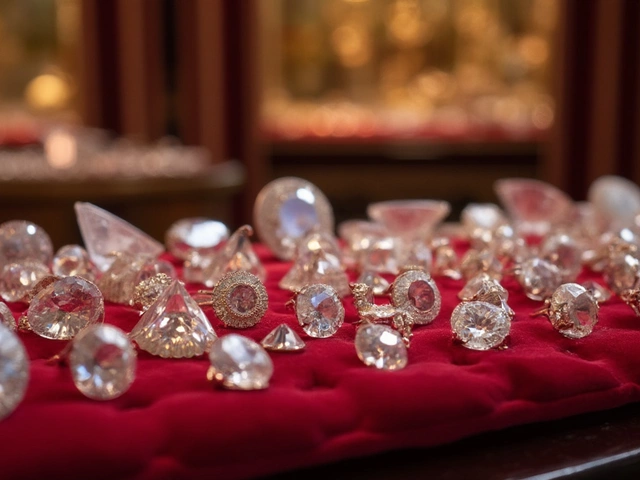
Thinking of diving into the world of jewelry making? Well, the first big step is finding the right supplier. It's like dating—you want someone reliable, trustworthy, and who gets you. So how do you even start this search? Here's the lowdown.
First, figure out what you need. Are you working on dainty bracelets, statement necklaces, or maybe some chunky rings? Different projects require different materials, and knowing what you’re after will help narrow things down. Plus, some suppliers specialize in specific types of materials, like gemstones or metals.
- Understanding Your Needs
- Where to Search for Suppliers
- Evaluating Supplier Quality
- Negotiating Terms and Pricing
- Building Long-term Relationships
Understanding Your Needs
Before you start your quest for the perfect jewelry supplier, it’s crucial to really grasp what you’re looking for. This step sets the stage for everything else, so let’s not skip it.
Start by asking yourself what kind of jewelry you’re planning to create. Is it casual wear, upscale pieces, or maybe something vintage-inspired? This will guide your material choices and help you focus on suppliers who provide precisely what you need. Materials can range from simple metal chains and clasps to exotic gemstones and handcrafted beads. You want to make sure your supplier stock aligns with your creative vision.
Also, think about the volume of materials you'll need. Are you experimenting with a few pieces to get started, or are you diving into mass production? Knowing the quantities can make it easier to filter out suppliers based on their minimum order requirements.
Budget is another key factor. Do a bit of research to find out average prices for the materials you plan to use. This way, you’ll be better prepared when comparing pricing from different suppliers. Remember, a higher price doesn’t always guarantee better quality, but consistently low prices might raise red flags for quality concerns.
At the end of the day, understanding your needs isn’t just about the products. It’s also knowing how you want to grow your brand. Whether it's maintaining a boutique aura or expanding into international markets, this will influence the suppliers you aim to partner with.
A solid grasp of these factors will lead you to a more targeted search, saving you time and headaches down the line!
Where to Search for Suppliers
Finding a reliable jewelry supplier can feel like searching for a needle in a haystack, but with the right direction, it gets easier. Start by exploring online marketplaces. Websites like Alibaba, Etsy, and eBay have sections dedicated to wholesale jewelry making kits and materials. They offer a huge range and let you compare prices and reviews from the comfort of your couch.
Don’t forget about attending trade shows and craft fairs. These events are goldmines for meeting suppliers face-to-face. You can see their products in person, which is super valuable when you're checking quality. Plus, forming a personal connection could lead to better deals.
If you're into tech, social media platforms like Instagram and LinkedIn are also great places to find and connect with potential suppliers. Many businesses showcase their offerings there, allowing you to see their products in action.
Local is another option. Check out local craft stores or regional supply shops. Building a relationship locally can sometimes result in quicker delivery times and more personalized service.
| Marketplace | Focus Area | User Reviews |
|---|---|---|
| Alibaba | Mass production | Mixed; check ratings and feedback |
| Etsy | Artisanal and small batches | Generally good for quality |
| eBay | Variety and competition | Be cautious; look for trusted sellers |

Evaluating Supplier Quality
Alright, so you've found a few potential jewelry suppliers. How do you know they won't send you a bag of rocks instead of gemstones? Checking out the quality of your supplier is a must if you want top-notch products for your creative projects.
First thing's first—do your homework. Look for online reviews or ask for recommendations from fellow jewelry makers. If a supplier has a history of delivering damaged or incorrect items, that's a red flag. Additionally, if they have a website, browse through it and see if they showcase their products with good images and clear descriptions.
Ordering samples is also crucial. Most legit suppliers will let you purchase or even send free samples so you can assess the quality firsthand. Pay attention to details like the weight, finish, and durability of the materials. If something feels off, trust your gut.
- Check certifications: Reliable suppliers might have certifications indicating their materials meet quality standards. Certifications can be like a little stamp of trust.
- Communication: If they're quick to answer your questions and provide information, that’s a good sign. Good communication means they're willing to work with you towards your specific needs.
- Return policy: A fair return policy can save you from a world of hurt if something doesn't meet your expectations. Make sure you know what to expect if things go south.
| Factor | Importance |
|---|---|
| Sample Quality | High |
| Certifications | Medium |
| Communication | High |
| Return Policy | High |
Remember, a good jewelry supplier isn't just a one-time deal. You might be in it for the long haul, so take the time to evaluate thoroughly. A little effort now can save you a heap of trouble later on.
Negotiating Terms and Pricing
Got your eye on a potential jewelry supplier? Awesome! But hold your horses—before you sign on the dotted line, learn a few negotiation tricks to make sure you're getting what you need without overspending.
First off, know your market. Understanding how much typical jewelry making kits should cost can give you a solid advantage when discussing prices. Check out a few suppliers to get a baseline idea.
When it’s time to talk pricing, consider these steps:
- Volume Discounts: The more you buy, the less you'll pay per piece. So if you’re planning on making a hundred pairs of earrings, mention it.
- Bundling Offers: If you need multiple types of materials, ask if there’s a discount for bundling them together.
- Payment Terms: Discuss whether they offer better rates for upfront payments or larger orders. Net-30 or net-60 terms could also be on the table, giving you more flexibility with payments.
Also, don’t hesitate to ask about their typical lead times and return policies. These might affect your costs, especially if you're on a tight schedule and need to pay extra for faster shipping.
Here’s a little stat that might interest you:
| Method | Average Discount |
|---|---|
| Volume Purchase | 5-10% |
| Early Payment | 2-5% |
Lastly, build a relationship with your supplier. Your suppliers are much more likely to offer better terms if they see you as a reliable customer who can offer them repeat business. So be that customer.

Building Long-term Relationships
Once you've found a promising jewelry supplier, it's all about cultivating a relationship that's going to last. Think of it like any good friendship or professional partnership—you've got to invest time and effort.
Stability in supply lines is gold, especially for jewelry making kits where consistency in materials is key. Here’s how you can build and maintain that crucial supplier bond:
- Communication is Key: Regular and open communication can prevent misunderstandings. Make sure both parties are clear about terms, expectations, and updates. It’s not just about placing orders, but sharing feedback and future needs.
- Be Reliable: Just as you expect reliability, be consistent with your orders and payments. A reputation for prompt payment can earn you better terms or priority during stock shortages.
- Mutual Benefits: Look for ways you can benefit each other. Maybe you can provide them with feedback on new products, or help with a shout-out if they’re doing a good job. Sometimes, a small gesture can go a long way in strengthening your bond.
- Flexibility and Understanding: Problems can arise—the key is how you both handle them. Being flexible during hiccups, like a late shipment, and working together on solutions makes your relationship more resilient.
Over time, these relationships might not only lead to more favorable pricing and terms but also to exclusive first dibs on new materials or designs they might develop.
Building a long-term supplier relationship isn't just about transactions. It's about cooperation and understanding, where both parties feel valued and invested. This not only helps your current projects but also sets a solid foundation for any future creative endeavors.


